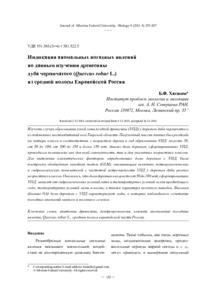Индикация аномальных погодных явлений по данным изучения древесины дуба черешчатого (Quercus robur L.) из средней полосы Европейской России
Скачать файл:
URI (для ссылок/цитирований):
https://elib.sfu-kras.ru/handle/2311/2810Автор:
Хасанов, Б.Ф.
Khassanov, Bulat F.
Дата:
2011-12Аннотация:
Изучены случаи образования узкой зоны поздней древесины (УПД) у деревьев дуба черешчатого
из пойменных местообитаний юга Тверской области. Полученный массив данных был разделён
на четыре класса в соответствии с возрастом дерева в год образования УПД: моложе 50,
от 50 до 100, от 100 до 150 и более 150 лет. Анализ доли деревьев, сформировавших УПД,
проводился независимо как для всей совокупности, так и для указанных возрастных классов.
Для выделения климатических факторов, определяющих долю деревьев с УПД, была
построена обобщённая линейная модель (GLM), связывающая величины метеорологических
и гидрологических показателей с частотой встречаемости УПД у деревьев дуба разных
возрастных классов. Оказалось, что доля деревьев в возрасте от 50 до 100 лет, сформировавших
УПД, зависит от гидрологических условий лета и температурных условий осени предыдущего
года, температурных условий зимы и весны, а также характера весеннего паводка. Высокая
(больше 0,6) доля деревьев с УПД характеризует годы, в которые наблюдалось сочетание
погодных аномалий зимнего и весеннего сезонов. Cases of the development of narrow latewood were studied in the tree rings of oaks from the flood
plain forests (south part of Tver region). Data were divided into four grades according to the tree age
in the year of narrow latewood formation: less then 50, from 50 to 100, from 100 to 150 and more then
150 years. Analysis of fraction of trees with narrow latewood was conducted separately for all trees
as well as for different age classes. Climatic factors, which affect the fraction of trees with narrow
latewood were specified with Generalized Linear Model (GLM). The best model fit connected the
fraction of trees with narrow latewood (age class from 50 to 100 years) to hydrological conditions
of previous summer and temperature of previous autumn, winter and spring as well as a magnitude
of spring flood. High fraction of trees with narrow latewood (more then 0.6) indicates years with
combinations of extreme weather events in winter and spring.
Коллекции:
Метаданные:
Показать полную информациюСвязанные материалы
Показаны похожие ресурсы по названию, автору или тематике.
-
Genetic diversity and differentiation of introduced red oak (Quercus rubra) in Germany in comparison with reference native North American populations.
Tim A. Pettenkofer; Katharina, Burkardt; Christian, Ammer; Torsten, Vor; Reiner, Finkeldey; Markus, Müller; Konstantin, Krutovsky; Barbara, Vornam; Ludger, Leinemann; Oliver, Gailing (2019-04)Northern red oak (Quercus rubra) was introduced to Europe in the late 17th century and is today the most important deciduous foreign tree species in Germany. Despite its importance little is known about the origin of local ... -
Development of novel Quercus rubra chloroplast genome CAPS markers for haplotype identification : научное издание
Pettenkofer Tim; Finkeldey Reiner; Mueller Markus; Krutovsky Konstantin; Vornam Barbara; Leinemann Ludger; Gailing Oliver (SCIENDO, WARSAW, 2020)Our main objective was to generate cost-effective chloroplast (cp) DNA markers that are easy to apply and to score. In combination with already published cpSSR markers they should increase haplotype resolution in populations. ... -
Chloroplast haplotypes of Northern Red Oak (Quercus rubra L.) stands in Germany suggest their origin from northeastern Canada
Goetz Jeremias; Krutovsky Konstantin; Leinemann Ludger; Mueller Markus; Rajora Om P.; Gailing Oliver (MDPI AG, 2020)Northern red oak (Quercus rubra L.) is one of the most important foreign tree species in Germany and considered as a major candidate for prospective sustainable forestry in the face of climate change. Therefore, Q. rubra ... -
Genetic variation of introduced red oak (Quercus rubra) stands in Germany compared to North American populations : научное издание
Pettenkofer Tim; Finkeldey Reiner; Mueller Markus; Krutovsky Konstantin V.; Vornam Barbara; Leinemann Ludger; Gailing Oliver (SPRINGER, NEW YORK, 2020)Although Northern red oak (Quercus rubra L.) is the most important introduced deciduous tree species in Germany, only little is known about its genetic variation. For the first time, we describe patterns of neutral and ... -
Genetic variation of introduced red oak (Quercus rubra) stands in Germany compared to North American populations
Tim, Pettenkofer; Reiner, Finkeldey; Markus, Müller; Konstantin V. Krutovsky; Barbara, Vornam; Ludger, Leinemann; Oliver, Gailing (2020-04)

